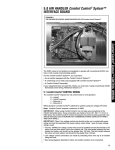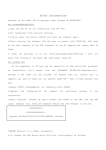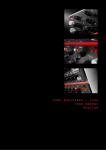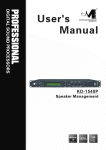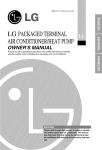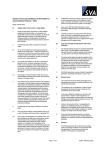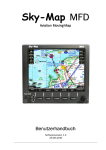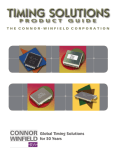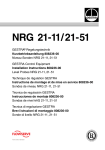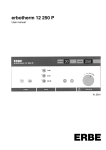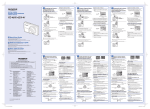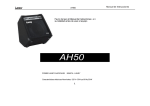Download User manual LIAM
Transcript
1 REaD THIS manUaL BEfoRE USInG THIS pRoDUCT! Important Safety Information Inside. Keep this manual in a safe place for future reference USER manUaL written by Helmut Butz. all rights reserved! Important Safety Information! Important Safety Information! Important Safety Read, keep and follow allInformation! instructions. Heed all warnings. 2 Read, keep and follow all instructions. Heed all warnings. Read, keep and follow all instructions. Heed all warnings. Electric shock! Electric shock! To avoid death or serious injury Electric shock! To avoid death orserious serious injury • Never open the unit, it works with high operating voltages and contains no user To avoid death or injury serviceable parts. Coming in contact with these voltages can be lethal. • Never open open the unit, works high operating voltages voltages and contains user no user • Never theitunit, it with works with high operating andno contains serviceable parts. parts. Coming in contact with these voltages can be lethal. serviceable Coming in contact with these voltages can be lethal. • Never operate the unit without proper earth connection! Improper earth connection cause voltageproper on units surface. • Nevercan operate thelethal unit without earth connection! Improper earth connection can • Never operate the unit without proper earth connection! Improper earth connection cause lethal voltage on units surface. can your cause lethalitvoltage on units surface. that the 3-wire power cord is correctly • For safety, is extremely important, •For your safety, itto is extremely important, thatpower the 3-wire power cord is correctly connected connected a grounding type 3-pin outlet. • For your safety, it is extremely important, that the 3-wire power cord is correctly to a grounding type 3-pin power outlet. connected a grounding type 3-pin powerpower outlet.outlet for proper grounding. If in doubt, to contact an electrician to check If in doubt, contact an electrician to check power outlet for proper grounding. Ifuse in doubt, anpower electrician power outlet for proper grounding. • Never a contact damaged cord!to Replace it immediately! • Never ause damaged power cord! Replace itcheck immediately! Protect the use power cord from being on or pinched. • Never damaged power cord! it immediately! Protect thea power cord fromwalked beingReplace walked on or pinched. •Refer to qualified personnel service or repair. Protect power cordfor from being walked on or pinched. • Refer to the qualified personnel for service or repair. • Refer to qualified personnel for service or repair. Electric shock! Electric shock! Electric shock! To avoid death orelectric seriousconductive injury • Touching liquids or objects, that have been fallen or spilled into the unit, canconductive cause an electric shock. •Touching electric liquids or objects, that havethat beenhave fallen or spilled the into • Touching electric conductive liquids or objects, been fallen into or spilled unit, Never can unit, cause an such electric shock. the can causeliquids an electric shock.Disconnect mains plug and refer to qualified touch or objects! service or repair to avoid serious injury! Neverpersonnel touch suchfor liquids or objects! Disconnect mains plug and refer to qualified Never touch such liquids or objects! Disconnect mains plug and refer to qualified personnel for service or repair to avoid serious injury! personnel for service or repair to avoid serious injury! High loudness levels! High loudness levels! High • loudness Depending levels! on the kind of signal chain and monitoring speaker system, its settings and environment, unit can create harmful loudness levels. To avoid permanent To avoid death or serious the injury • Depending on the kind of signal chain and monitoring speaker system, its settings hearing loss, set the volume of your monitoring system carefully! •Depending on the kind of signal and monitoring speaker system, and and environment, the unit chain can create harmful loudness levels. its Tosettings avoid permanent environment, the sound unit create harmful loudness levels. To avoid permanent hearing loss, setcan the volume of your monitoring system carefully! • Continuous pressure levels over 85dBSPL (measured directly hearing at the ear) will loss,cause set thepermanent volume of your monitoring system carefully! hearing loss. Do not exceed this level! • Continuous sound pressure levels over 85dBSPL (measured directly at the ear) will •Continuous sound pressure levels over 85 dBSPL (measured directly at the ear) will cause permanent hearing loss. Do not exceed this level! cause permanent hearing loss. Do not exceed this level! 1 1 Important Safety Information! 3 High Hightemperatures! temperatures! High temperatures! • Continuous operation increased surface temperatures of more than on •Continuous operation causescauses increased surface temperatures of more than 35° C/95° F 35° C/95° F on the backside of the unit. Touching thi s surface area can be painful. Do • backside Continuous operation causes surface oftouch morebackside than the of the unit. Touching thisincreased surface area can betemperatures painful. Do not not touch backside unit orunit. install unit in an rack. 35° C/95° on the backside of the Touching thiappropriate s surface area can be painful. Do of the unit orFinstall unit inofanthe appropriate rack. not touch backside of the unit or install unit in an appropriate rack. Heavy Heavyweight! weight! Heavy weight! • Due to weight and injury dimensions, moving or mounting of the unit may cause injury. To To avoid death or serious avoidtoinjury moving and mounting of the must always be handled by two • Due weight and dimensions, orunit mounting of may the unit may cause injury. To •Due to weight and dimensions, movingmoving or mounting of the unit cause injury. To avoid persons. injury and of the unitbe must always be handled injuryavoid moving andmoving mounting of mounting the unit must always handled by two persons. by two persons. Damage! Damage! Damage! • Unit will be damaged in case of a fall. Prevent falls by placing the unit on an even, stable surface orininstalling it in an appropriate rack.bythe • Unit will be damaged inof case ofPrevent a fall. Prevent falls placing the onstable an even, •Unit will be damaged case a fall. falls by placing unit on anunit even, stable surface it orininstalling it in an appropriate rack. surface or installing an appropriate rack. • Unit can be damaged, when set to the wrong operating voltage. Prior to the first •Unit can be damaged, when set tothe the wrong voltage. Prior the firstto Power Power Up, sure that operating voltage of the unit istoadapted tothe thefirst mains • Unit can bemake damaged, when set to the operating wrong operating voltage. Prior Up, make sure that the operating voltage of the unit is adapted to the mains voltage at the voltageUp, at the location of use. For mainsvoltage voltages 110 is toadapted 120VAC to setthe voltage Power make sure that the operating offrom the unit mains location of use. For mains voltages from 110 to 12 0VAC set voltage selector to pos. 115, selector to pos. 115, for voltages from 220 to 240VAC set to pos. 230. voltage at the location of use. For mains voltages from 110 to 120VAC set voltage for voltages 220 115, to 240 VAC set to pos. selectorfrom to pos. for voltages from230. 220 to 240VAC set to pos. 230. • Unit can be damaged, if fitted with improper fuse. Replace only with fuse of same •Unit type can be damaged, if fitted with improper fuse. Replace only with fuse of same type and and rating. • Unit can be damaged, if fitted with improper fuse. Replace only with fuse of same rating. type and rating. Fuse type: 5x20mm, slow blow, 2A@115V 1A@230V Fuse type: 5 x 20 mm, slow blow, 2A @ 115V 1A @ 230V Fuse type: 5x20mm, slow blow, 2A@115V 1A@230V • Unit can be damaged by connecting improper signals or DC-voltages in- and •Unit can be damaged by connecting improper signals or DC-voltages to in- and to outputs of outputs of unit. Do not feed high level speaker signals into the audio inputs. Do unit. Do not feed level speaker signals into the audio inputs. not connect • Unit can be high damaged by connecting improper signals or Do DC-voltages toP48 in- and not connect P48 to the audio outputs. phantom power to phantom theDo audio outputs. outputs of unit. notpower feed high level speaker signals into the audio inputs. Do not connect P48 phantom power to the audio outputs. Damage or or short circuit! Damage short circuit! Damage or short circuit! • High environment can cause damages or short circuits. To avoid To avoid death or serious temperatures injury overheating of a rack mounted unit, there be at rack space kept free • High environment temperatures candamages causeshould damages or least short½ circuits. To avoid •High environment temperatures can cause or short circuits. To avoid overheating above and below. overheating a rack unit, there should be atkept leastfree ½ rack kept free of a rack mountedof unit, theremounted should be at least 1/2 rack space abovespace and below. above and below. Do not install unit near heat sources such as radiators, heat registers, stoves etc., do not Do not install near heat sources such as radiators, heat registers, stoves etc., do not expose unit tounit direct sunlight. Do not install unit near heat sources such as radiators, heat registers, stoves etc., do not expose unit to direct sunlight. expose unit to direct sunlight. 35°C/95°F on the backside of the unit. Touching thi s surface area can be painful. Do not touch backside of the unit or install unit in an appropriate rack. Heavy weight! 4 Important Safety Information! • Due to weight and dimensions, moving or mounting of the unit may cause injury. To avoid injury moving and mounting of the unit must always be handled by two persons. Damage! Damage or short circuit • Unit will be case of a fall. Prevent falls by placingwill theoccur. unit on an even, •When moving thedamaged unit from in cold to warm environment, condensation stable surface or installing it in an appropriate rack. When powered up, this can cause damage or short circuit due to leakage current. In case of condensation, let unit dry completely before power up (at least 1hour or more). • Unit can be damaged, when set to the wrong operating voltage. Prior to the first Avoid humidity, if possible. Power Up, make sure that the operating voltage of the unit is adapted to the mains voltage at the location of use. For mains voltages from 110 to 120VAC set voltage Service requirements! selector to pos. 115, for voltages from 220 to 240VAC set to pos. 230. This unit should be repaired or serviced by qualified personnel whenever: • Unit can be damaged, if fitted with improper fuse. Replace only with fuse of same •Objects have fallen or liquid has spilled into the unit. type and rating. •Unit does not function properly or lacks in performance. Fuse type: 5x20mm, slow blow, 2A@115V 1A@230V •Unit has been dropped, heavily tilt or otherwise abused. • Unit can be damaged by connecting •Unit has been exposed to moisture or rain. improper signals or DC-voltages to in- and outputs of unit. Do not feed high level speaker signals into the audio inputs. Do not connect P48 phantom power to the audio outputs. Damage or short circuit! • High environment temperatures can cause damages or short circuits. To avoid overheating of a rack mounted unit, there should be at least ½ rack space kept free above and below. Thenot device hasunit been tested all respects Do install near heatinsources suchfor ascompliance radiators, heat registers, stoves etc., do not with theunit relevant EU directives expose to direct sunlight. and is CE certified. 2 Dear Valued C ustomer , Thank you for choosing a TOMO Audiolabs product. With the Preamp/EQ combination LIAM you have acquired a professional studio device which offers exceptional possibilities at highest quality levels. LIAM is exclusively built with high quality components. Quite many parts have been specially selected for their respective use and accuracy. There are premium quality rotary switches and potentiometers as well as special signal relays and in–house developed and manufactured signal transformers to provide the best possible audio quality to you. LIAM knows how to impress with extraordinary editing capabilities and a particular sound that emphasizes the respective sound sources. Also the technical details need not to hide. Alike our first, LISA, now LIAM is not only a professional studio tool. It´s meant to be personality like LISA to help you realizing your sound ideas and bring emotions to your music. For good reason we borrowed some parts from our LISA concept and combined them with an unconventional preamp design. LIAM incites your creativity and experimentational adventures in order to expand your possibilities in realizing your ideas. This manual is meant for your support for proper operating and experiencing LIAM. We wish you good luck, much fun and creativity… 5 Table of co nte nts Important Safety Information_______________________________________________2-4 Welcome!____________________________________________________________________ 5 Table of contents_____________________________________________________________ 6 Installation__________________________________________________________________ 7 Overview____________________________________________________________________ 8 Functions Preamp___________________________________________________________ 9 Functions Equalizer_________________________________________________________ 10 Tips and Tricks______________________________________________________________ 11 Block Diagram______________________________________________________________ 12 Warranty____________________________________________________________________ 13 EC Conformity______________________________________________________________ 14 Recall Sheet________________________________________________________________ 15 Technical Details____________________________________________________________ 16 6 In stallation LIAM offers following connections Front: HiZ IN Back: Mic In •High impedance instrument input for E-guitar/bass, acoustic instrument pickups, vintage keyboards etc., Mono/TS phone jack 6.3 mm • Microphone input, balanced, with switchable phantom power, XLR female Pre Out • Output of preamp section, impedance-balanced, XLR male Line In • Input of the EQ-section, balanced, XLR female •When insert switch is not activated then pre out signal is fed directly to the EQ-input •The activated insert switch allows you to insert external devices between preamp and EQ or to feed signal directly to the EQ-section (without going through the preamp) Main Out • EQ/Main Output, balanced, XLR male •6 dB level loss in case of unbalanced connections Link •Interface for dynamic linking of two units, TRS phone jack 6.3 mm •Use stereo/TRS cable! Mono/TS cables will short-circuit sidechain signals of the dynamic section 7 Overview 8 LIAM is made up as a three-stage preamplifier for microphone- and instrument signals with two special dynamic filters following. First stage of the preamp is selectable to be either a transformer balanced microphone amp or a high-impedance, unbalanced FET instrument amp. Second stage works with a transformer in a so called “Zero Field” circuit. This allows additional gain with very little noise and distortion. The amplifying element of the third stage finally is a tube (double triode). This tube stage is specially arranged for variably generating harmonics. The all in all max. gain of LIAM of more than 80 dB makes it usable for low level dynamic/ ribbon microphones. Preamp signal is present at the Pre Out jack and is lead to the input of the dynamic filters (Insert not active). The two dynamic filters are a loan from our LISA Mastering EQ and are adapted frequencywise for use with LIAM. They are arranged in the same parallel circuit as in LISA (mixing filtered and unfiltered, ”dry” signal). This allows very subtle as well as very extreme results. At the input of the EQ-section the signal is split, then lead through the filters and finally mixed with the unprocessed signal in phase (boost) or out of phase (cut). Additionally the unprocessed signal can be lowered down to zero continuously, which is useful if you want to hear the filters “in solo” as an assistant for adjusting, or for a more filter accentuated sound. The two overlapping, fully parametric shelv/peak filters with active feedback together cover the whole audio band. They both are equipped with a dynamic stage that works in a compressing or expanding style. These special dynamic stages are integrated directly into the active feedback filter circuit and therefore do not compare to usual dynamic EQs. More of that in the chapter “Functions” Fun ctio ns 9 Preamp P48 • turns on +48 VDC phantom power at microphone input jack. Do not switch when monitor system is set on higher levels. Phantom power is faded in and out softly, however some microphones produce uncontrolled transients. BRIGHT • Treble boost for HIZ input. 6 dB/oct. shelv @ 5 kHz, a bit like the bright switch on a guitar amp. HiZ IN • High-impedance (2 MΩ), unbalanced instrument input, designed for passive pickups of guitars, basses, vintage pianos etc. Of course you can use active instruments, too. Try out. HIZ GAIN • controls the level of the instrument input amp. MIC GAIN • sets the gain of the microphone input amp. Every step of the rotary switch is 2 dB. TUBE GAIN • controls the headroom/saturation of the tube stage. PRE OUT • controls the output level of the preamp-section or rather the input level for the EQsection. PRE OUT has no function if EQ is fed via the LINE IN jack. See block diagram! LO CUT • turns on the high pass filter. 6 dB/oct. @ 80, 150 or 250 Hz are selectable. AIR • turns on a high boost function. Approx. 4 dB/oct. @ 14k, 10 k or 7 kHz are selectable. MIC - HIZ • selects the corresponding Signal input amp. Ø • treverses polarity of microphone input. -20 dB • attenuates microphone input signal by 20 dB. INSERT • cuts the connection between preamp and EQ and switches the LINE IN jack on the EQ input. External devices can be inserted or the EQ can be fed directly via LINE IN jack, without going through preamp. LED VU-METER • shows the level at PRE OUT. About 6 dB before clipping the meter turns to red. Fun ctio ns 10 Equalizer Both filters are identically except for frequency ranges and shelv modes. So following description stands for both. BOOST/CUT • Switch is on (bright): Boost mode. Switch is off (dark): Cut mode. ON • turns on the whole filter. Q • the rotary switch selects the filter curve. Lower values create wide bell curves, higher values create narrow ones. Fully counterclockwise position works as a LoShelv on the low filter and as a HiShelv on the high filter. GAIN • controls the amount of boost or cut of the filter. Range is approx. ±15 dB. FREQUENCY • Rotary switch selects the center frequency of the filter. Low filter range: 12 Hz –1540 Hz. High filter range: 470 Hz – 26 kHz. Fx2 • Switch is on (bright): selected frequency is doubled. RATIO • changes ratio of compression/expansion style dynamic. Switch off (dark): low ratio, switch on (bright): high ratio. ON • turns on the dynamic stage. v^ • Switch on (bright): Compression style dynamic. Switch off (dark): Expansion style dynamic. DYN • this LED shows activities of the dynamic stage. Its intensity is an optical indicator for the behavior of the dynamic. ATT/REL • the rotary switch selects between six different attack/release preset combinations. First letter stands for attack, second for release: Fast Medium Slow. THRESHOLD • controls the sensitivity of the dynamic stage. OUTPUT GAIN • this control boosts the level of the output stage up to 12 dB. DRY LEVEL • controls the amount of unprocessed ”dry “signal relative to the filter signals. Full counterclockwise = no dry signal, full clockwise = 100 % dry signal. Tips a nd T ric k s 11 To get to know the special features of LIAM, we recommend to go on ahead step by step. Step 1: Preamp settings PRE OUT control at cw position, TUBE GAIN at 9 o`clock position, OUTPUT GAIN at full ccw position, DRY LEVEL at cw position, both filters off, turn up MIC GAIN or HIZ GAIN (according to used source) until VU-meter shows YELLOW at signal peaks. This setting produces a very clean and neutral sound. If TUBE GAIN is turned up and as a countermove PRE OUT turned down, the sound gets more and more colored and sounds “tuby”(for most guitarists a well-known effect). At appropriate settings you will even get some heavier distortion. This will perhaps not exactly match your vocal tracks, but some instruments will surely benefit from it. Since the LO CUT filter works at the input of the tube stage, you can clear up and slender the low end, especially in distortion mode. AIR filter works directly in the tube stage so it’s the right choice if you want that silvery shine on your highs. Step 2: Equalizer settings Quick start for the EQ (both filters): Switches for BOOST/CUT, v^ and RATIO are on, Q is set to 0,4 and ATT/REL at FF. Filters and dynamics are off. GAIN, FREQUENCY and THRESHOLD are set at 12 o`clock position. With this basic setting you initially will hear only the unprocessed, “dry “- signal. Now you can turn on one of the filters, which gives a static boost of about 7 dB to the selected frequency. By turning on the dynamic function this static boost will be partly “eliminated”, depending on the signals shape. The more you turn down the DRY LEVEL, the better you can hear the static and dynamic effects of the EQ filters. For normal use of the EQ low DRY LEVEL settings would be probably a bit too extreme. But sometimes one needs special methods for special results. Also you can use the DRY LEVEL for controlling your filter settings (sort of filter solo function). Attention! If filters run in CUT mode, then turning down DRY LEVEL to 0 will result in total silence. This is normal behavior! Since the EQ uses the in phase and out phase mixing principle, there would be no signals to be mixed. Note: Dynamic functions will be mirrored when filters are switched from BOOST to CUT. Example: Expander style BOOST mode increases dynamically the boosted frequencies. Expander style CUT mode in addition decreases dynamically the signal. Step 3: Experiments Based on the quick start settings now it`s time to explore the possibilities of LIAM experimentally. Get into extended sessions with different kinds of program material. “Trust your ears. The end justifies the means”. B lock Diagram MIC IN 12 MIC AMP ZERO FIELD AMP HIZ AMP TUBE AMP TUBE GAIN PRE OUT HIZ IN VU DRY LEVEL LINE IN HI EQ LO EQ PRE OUT MIX AMP MAIN OUT Warra nty 13 LIAM comes with a limited warranty, covering defects in materials or craftsmanship or malfunction. The limited warranty is valid for two (2) years from the date of purchase. The warranty only covers the original purchaser and is non-transferable. Additionally, it does not cover defects or loss caused by •normal wear and tear •abuse, misuse, failure to follow the instructions and warnings in the owner´s manual •repairs or modifications performed by unauthorized personnel •unauthorized modifications performed without written permission from TOMO Audiolabs or improper assembly and maintenance •power surge damage or damage from either too high or low a voltage entering the unit. We advise you to check if this type of damage is covered by the insurance of your local power company •applied phantom power to the outputs of the unit •damage during transport or involvement in an accident (always take out transport insurance!) We will either repair or replace any LIAM that is defective in materials or workmanship or malfunction, at no charge. Please contact our return department before returning equipment to TOMO Audiolabs. Always use the original packaging for returns. Units returned without original packaging will get a new box and it will be charged to the client. This is necessary to prevent transport damage and to meet the requirements of transport insurance guidelines. It is absolutely necessary to contact TOMO Audiolabs before returning units from outside of Germany. TOMO Audiolabs will not, under no circumstances, pay for customs duty fees and/ or fees caused by wrong or inaccurate specifications or labeling. For technical support, please contact: TOMO Audiolabs, Gebrüder Frei GmbH & Co., Elektrotechnik/Elektronik, Borsigstraße 15, 72461 Albstadt, http://www.tomo-audiolabs.de/ (Gebrüder Frei GmbH & Co.) Borsigstraße 15 72461 Albstadt Tel. +49 7432 202-0 Fax +49 7432 202-550 [email protected] www.tomo-audiolabs.com EC declaration of conformity The company Gebr. Frei GmbH & Co., Borsigstr. 15, 72461 Albstadt, declares in full responsibility that the discribed product (LIAM) corresponds to the following standards and instructions. Low-voltage directive according 2006/95/EC Standard for assessing: •EN 60065 Electromagnetic compatibility (EMC) according 2004/108/EC Standards for assessing: •EN 55103-1 interference audio device •EN 55103-2 immunity audio device Responsible for the above mentioned manufacturer this Declaration is executed through: Albstadt, July 11, 2013 Tomo Audiolabs (Gebr. Frei GmbH & Co) Kommanditgesellschaft Sitz Albstadt Registergericht Stuttgart HRA 400484 Persönlich haftende Gesellschafterin Frei Beteiligungs-Gesellschaft mbH Sitz Albstadt Registergericht Stuttgart HRB 400128 Geschäftsführer Thomas Frei USt-IdNr.: DE 144 838 308 LIAM Recall Sheet Artist: ________________________________________________________________________ Date: ________________________________________________________________________ Song/Notes:_________________________________________________________________ ______________________________________________________________________________ ………………………………………………………………………………………………........ Song/Notes: ……………………………………………………………………………………. Date: ……………………………………………………………………………………………. Artist: …………………………………………………………………………………………… LIAM Recall Sheet 12 L IAM R ecall Sheet 15 Technical Specificatio n s 16 Preamp •Frequency response (±0,5 dB): •Equivalent Input Noise EIN @ Rs = 200 Ω, Gain 80 dB (22 Hz – 22 kHz unweighted): •THD + N: depends on TUBE GAIN, from •Input, max. level and impedance: •Output, max. level and impedance: 10 Hz – 30 kHz -128 dBu 0.03 % to heavy distortion MIC +24 dBu @ 2 k Ω Instr. +10 dBu @ 2 MΩ +24 dBu @ 120 Ω Equalizer •Frequency response (±0,5 dB): •Noise (22 Hz – 22 kHz unweighted): •Dynamic range: •THD + N: 10 Hz – 35 kHz -90 dBu max. 120 dB 0.02 % •Input, max. level and impedance: +24 dBu @ 20 k Ω •Output, max. level and impedance: +30 dBu @ 100 Ω •Filter gain ± 15 dB each, Filter-Q 0.4 – 6 each Lo frequency band: 12 Hz – 1540 Hz Hi frequency band: 470 Hz – 26 kHz Tube type: 12AU7/ECC82 Size and weight •Width 483 mm x Height 88 mm x Depth 318 mm •Net: 8 kg Mains •115/230VAC, 50 – 60 Hz, 50 W •Fuse 5 x 20 mm, 0.5AT @ 230V 1AT @ 115V

















